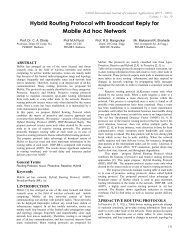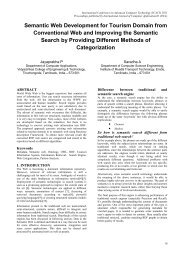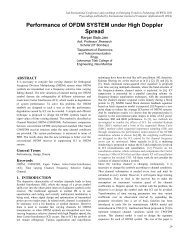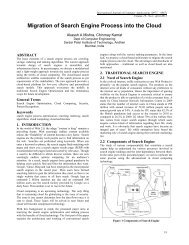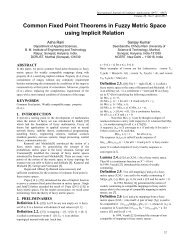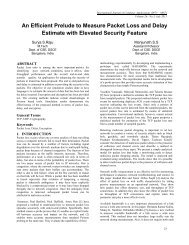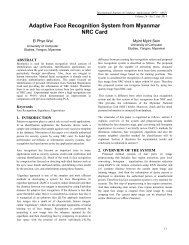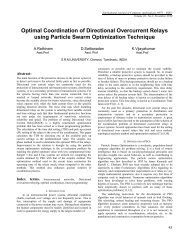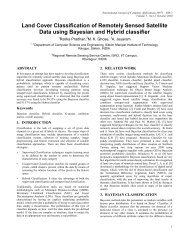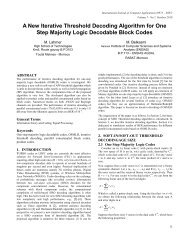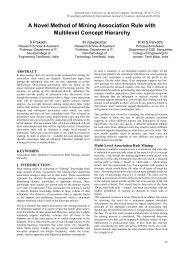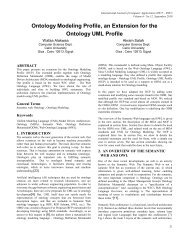Region of Interest Tracking In Video Sequences - International ...
Region of Interest Tracking In Video Sequences - International ...
Region of Interest Tracking In Video Sequences - International ...
Create successful ePaper yourself
Turn your PDF publications into a flip-book with our unique Google optimized e-Paper software.
<strong>In</strong>ternational Journal <strong>of</strong> Computer Applications (0975 – 8887)<br />
Volume 3 – No.7, June 2010<br />
moments<br />
1<br />
2<br />
3<br />
4<br />
5<br />
6<br />
7<br />
Table 1. 2-D moment invariants<br />
2.3. Similarity measures<br />
Let IR be the reference frame in which the ROI is defined and<br />
IT is the target frame in which the ROI is determined using the<br />
similarity measures. The amount <strong>of</strong> similarity is given by the<br />
geometric transformation<br />
arg min<br />
Sample video 1 Sample video 2<br />
Original<br />
Original<br />
Scaled ROI<br />
Scaled ROI<br />
ROI<br />
ROI<br />
0.0013261 0.0013315 0.0013235 0.0013264<br />
2.059e-09 1.87e-09 1.33e-08 1.349e-08<br />
1.05e-10 1.057e-10 6.314e-11 6.269e-11<br />
1.20e-10 1.217e-10 7.51e-11 7.437e-11<br />
1.09e-20 1.10e-20 4.05e-21 4.083e-21<br />
-1.15e-10 -1.16e-10 -7.36e-11 -7.31e-11<br />
8.07e-21 8.307e-21 3.216e-21 3.018e-21<br />
D<br />
KL<br />
( I<br />
R<br />
, I<br />
T<br />
)<br />
Where DKL is the Kullback Leibelr divergence between the<br />
reference and the target frames. Normally similarity measures<br />
are determined in two ways. They are colour based and<br />
geometry based. The colour based method checks if the regions<br />
have similar colours and the geometry checks if these colours<br />
appear at the same location.<br />
(7)<br />
between the reference and the target frames. A function <strong>of</strong><br />
residual can serve as a similarity measure, classically in the<br />
discrete framework, SSD<br />
D<br />
SSD<br />
( I<br />
2<br />
T ,<br />
I<br />
R)<br />
( T ( x)<br />
R(<br />
x))<br />
x<br />
(11)<br />
Or function used in robust estimation such as SAD or<br />
differentiable approximation <strong>of</strong> SAD<br />
D ))<br />
SAD( IT<br />
,<br />
I<br />
R)<br />
( T ( x)<br />
R(<br />
x<br />
(12)<br />
x<br />
3. EXPERIMENTAL RESULTS<br />
This algorithm had been tested on several video datasets. The<br />
appearance <strong>of</strong> the object and its background keep changing<br />
during almost all the time. The exciting results are obtained in<br />
most experiments. Here three video sequences are used to test<br />
the ability <strong>of</strong> the algorithm to track object deformations and<br />
shifts. Only the first frame in every 30 frames is used to force<br />
the motion and deformations to be large. <strong>In</strong> the first frame, a<br />
rectangle is interactively selected by the user. Although the user<br />
specifies a rectangle to cover the object to find the feature point<br />
selection, all the feature points are located inside the object. The<br />
experiments also prove that the tracking algorithm is very<br />
efficient.<br />
3.1 Experiment-I<br />
This video sequence consists <strong>of</strong> 174 frames and 29.966 frames<br />
per second. Here the window size is changed to 80X80. This<br />
will result more tracking accuracy than the previous video.<br />
Fig.2. shows the tracking results <strong>of</strong> the particular ROI.<br />
2.3.1. Colour based similarity measures<br />
One <strong>of</strong> the colour based similarity measure used for tracking is<br />
Bhattacharya distance.<br />
DBHA ( IT<br />
, IR)<br />
fR(<br />
s)<br />
fT<br />
( s)<br />
ds<br />
(8)<br />
Another widely used similarity measure is the Kullback-<br />
Leibler distance<br />
D<br />
KL<br />
( I , I )<br />
T<br />
R<br />
f ( s)log<br />
T<br />
fT<br />
( s)<br />
ds<br />
f ( s)<br />
R<br />
(9)<br />
Frame 1<br />
This equation can be decomposed as follows<br />
DKL ( IT<br />
,<br />
I<br />
R)<br />
fT<br />
( s)log<br />
fT<br />
( s)<br />
ds<br />
fT ( s)log<br />
fR(<br />
s)<br />
ds<br />
= I ) H ( I , I )<br />
H (10)<br />
(<br />
T<br />
T R<br />
Where H is the differential entropy and HX is the cross entropy,<br />
also called relative entropy or likelihood.<br />
2.3.2. Geometry based similarity measures<br />
Frame 30<br />
Frame 60<br />
Geometry can be added by using transformation , which<br />
represents a motion model, to compute the pointwise residual<br />
34


